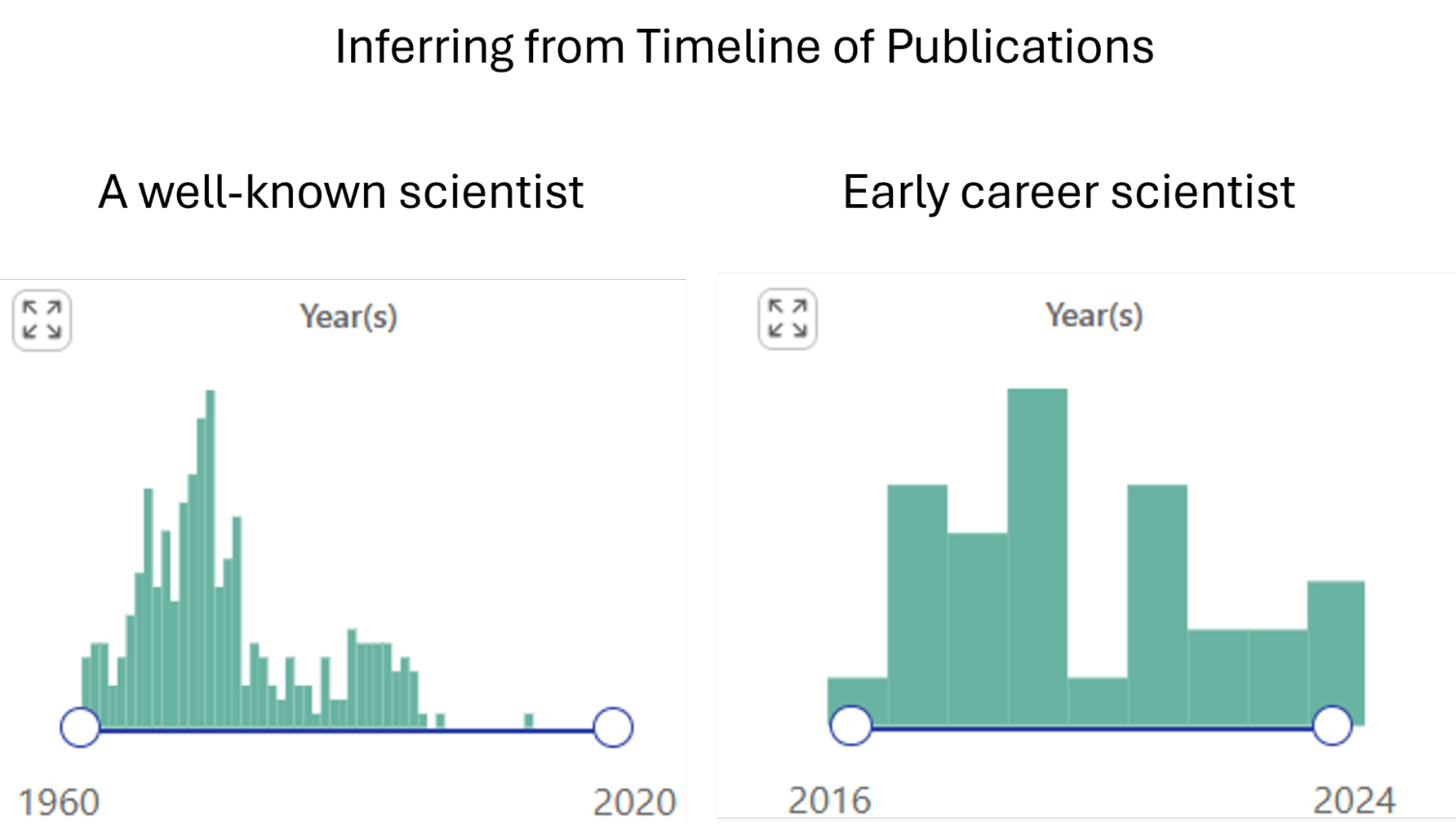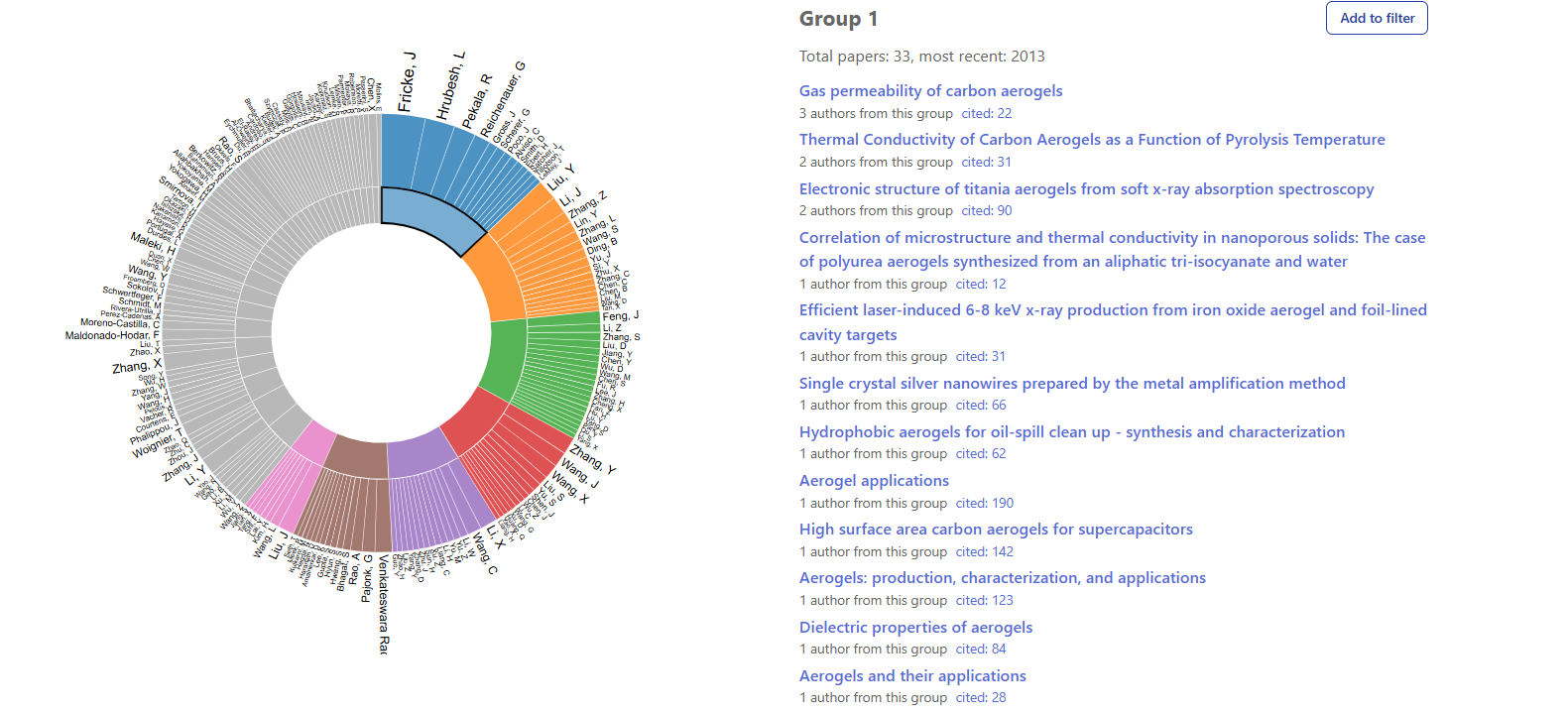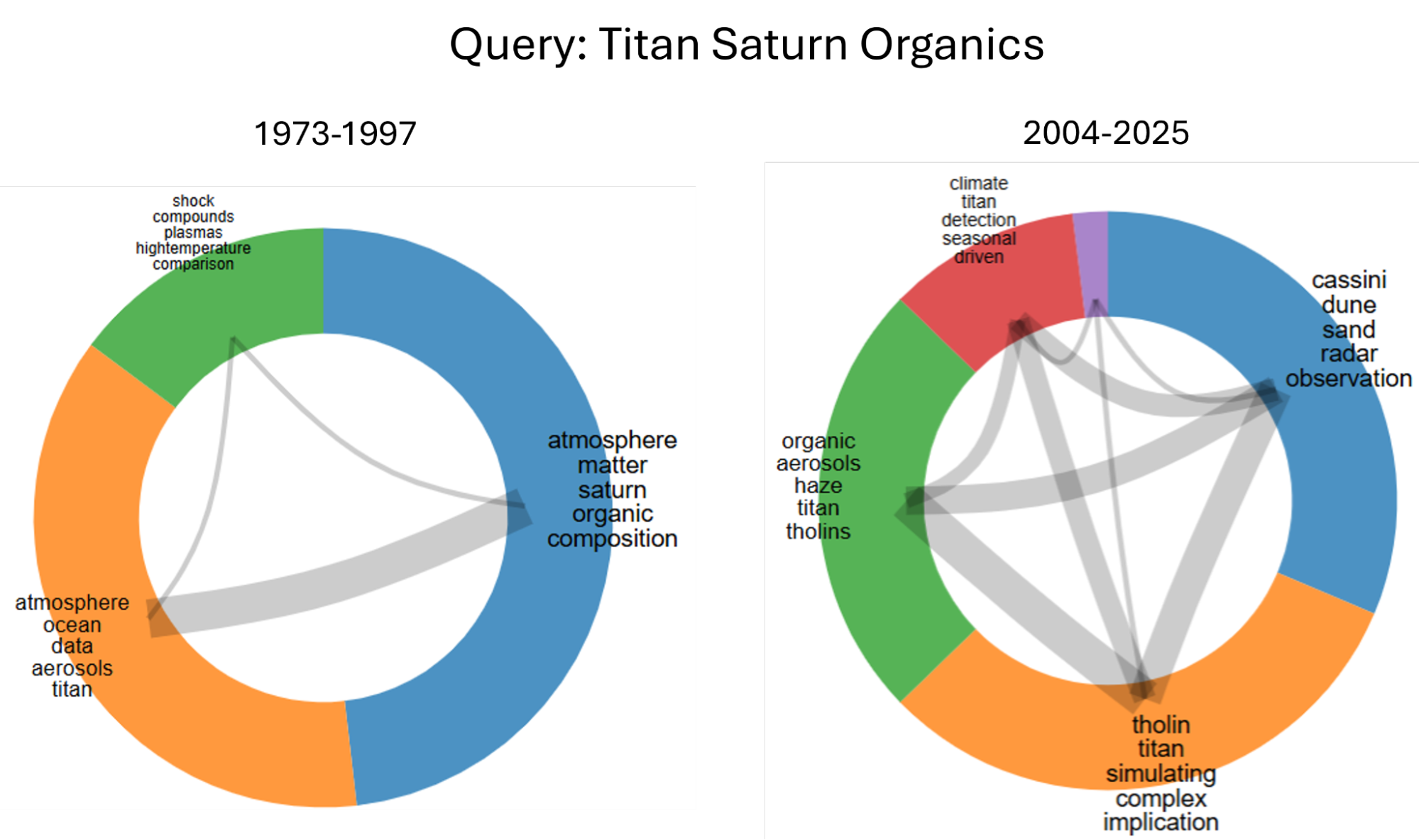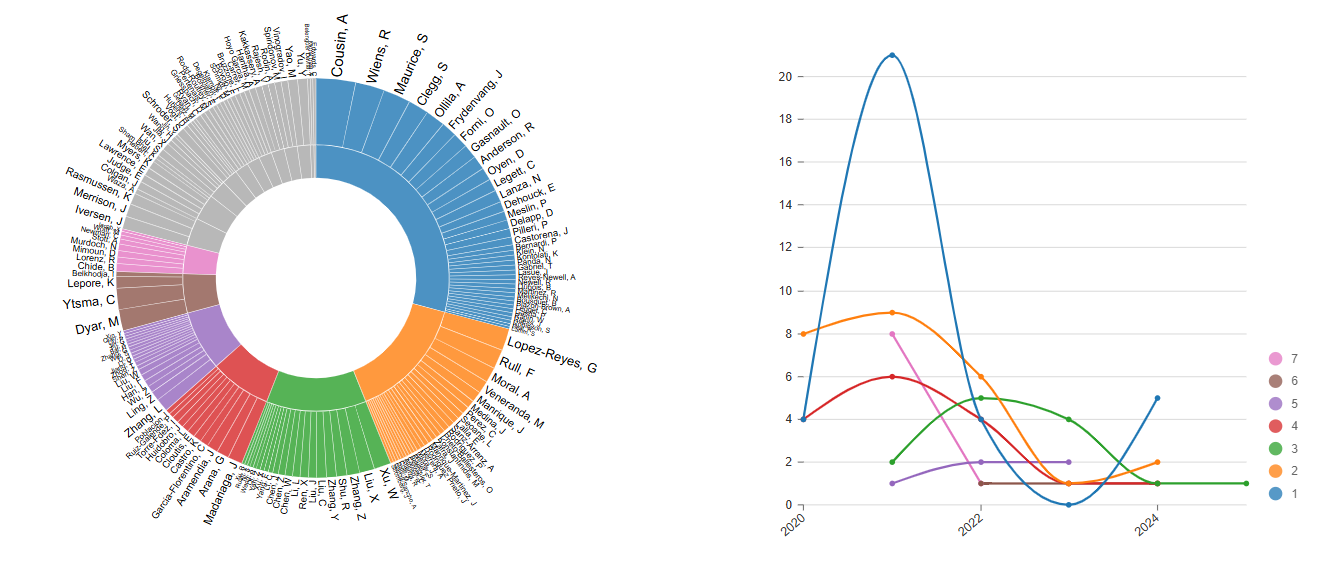The Power of Visualizations
Sarah Lamm (SciX Ambassador)
01 Jul 2025
I’m Sarah Lamm, a PhD candidate in the Geology Department at the University of Kansas. As many scientists know, being in a certain department doesn’t mean your research or interests are limited to a single discipline. I consider myself interdisciplinary not only because of my background in chemistry and geography, but also because my research focuses on how mineral spectra change with small chemical or microstructural variations. I then relate these findings to planetary science. This work spans material science, physics, and technology, in addition to geology and chemistry. This is why SciX is powerful: it pulls scientific references from multiple disciplines and brings them together in one searchable platform. After you’ve submitted a query in SciX, you have the option to visualize the results. Go to explore in the top right hand corner right above your results. You have six options: overview, metrics, author network, paper network, concept cloud, and results graph. But what’s the power in that? I love figures, graphs, and tables, and I know I’m not alone. Many people prefer a clear visual over reading long paragraphs of text. As the saying goes, a picture is worth a thousand words. That’s why the visualization tools in SciX are my favorite feature, especially when I’m starting a new research topic. The SciX visualizations help me quickly identify key authors, papers, related topics, and even methodologies. This gives me a faster and more focused entry point into the current understanding of a subject. It allows me to move beyond just reading the most relevant, but possibly generic, results.
When the Query is a Person (Name or ORCID)
Situation: You just overheard someone mention a scientist’s name at a conference, and you are about to meet them. Though the problem is you’ve never heard of them before, and you have less than 10 minutes to learn everything you can. What is their area of expertise? Are they still active in the field or just starting out? Are they highly cited? Do you know someone who can introduce you? How will you find all of this out quickly?
The answer is SciX visualizations, which give you a snapshot of someone’s research journey. Here is just a small sample of what you can discover:
- Timeline of Publications
See when someone started publishing and whether they’ve published recently—either as a co-author or first author. This can offer clues about:
- Their career stage (just starting out vs. winding down)
- If they’re actively publishing or possibly scaling back
- Whether they’re someone you might connect with as a peer or mentor

As someone who will soon be on the post-doc market, I will be looking for a post-doc mentor who is actively publishing. So neither of these options, as one is no longer active, and the other one is a current student.
- Citations & Reads
- Check how often their work is cited.
- See if their publications are being read on SciX—this can highlight current interest in the field.
- Author Network
- Curious about their collaborators? The Author Network reveals who they work with and how they’re connected.
- Concept Cloud
If you don’t know much about this person, the Concept Cloud is a great shortcut:
- See their areas of expertise and what they’ve been involved in over time
- Spot trends in their research interests
When the Query is a Topic or Set of Keywords
Problem: You’ve been assigned to collaborate on a project in an area where you have minimal expertise. Don’t panic, just head over to SciX. SciX shows you the key papers on a topic and the authors who have worked on it.
- Paper Network
- Identify foundational or influential papers.
- Understand how various works are interconnected.
- Author Network
- See who’s publishing in that field.
- The bigger the name, the more they’ve contributed.

A side project I’m collaborating on has suggested the use of aerogels, which is not something I have ever worked on or even considered before. So I headed over to the author network using the query “Aerogels.” I quickly learned who the main group of researchers in this field is, identified as the blue group, and noticed that their most recent collaboration, shown on the right, was in 2013. This helped me realize that while this group has published the most on the topic, they may not have the most recent papers.
Individual authors can be selected to see how their specific work contributes to the main query. This network visualization highlights both collaboration patterns and individual contributions within the field of aerogel research.
- Concept Cloud
- Get a quick overview of what’s been explored.
- See what’s been attempted or theorized.
Pro Tip: Filter by Years
People and ideas change over time, so maybe you aren’t interested in every paper available. Visualizations even respond when filtered by year. How many scientists have changed research focus from when they were a student to their current career stage? If you don’t filter by year you are getting everything this ever worked on, which might not be useful.
- For People
- See what someone has worked on recently.
- Narrow their author or paper network to recent collaborators.
- Get a clearer view of their current focus via the Concept Cloud.
Same with topics, how many hypotheses have been thrown out over time, or have recently developed into complex theories? Filtering topics to most recent years will give you an idea of where the current line of thought is.
- For Topics
- Find the latest thinking on subjects like “Enceladus Organics” or “Venus clouds.”
- Discover new hypotheses, proposed missions, or instrument ideas.
- It’s a fast, effective way to get up to speed on current conversations in the field.

Paper Networks based on the query “Titan Saturn Organics” are a great example of the power of filtering by years. The paper network on the left shows papers from 1973, which is the first time these keywords show up, through to the launch of Cassini and Huygens in 1997. This represents some of scientists’ earliest hypotheses about organics on Titan, and these references were used to justify sending Cassini and Huygens. The paper network on the right includes everything after Cassini arrived at Saturn and goes up to today. The ideas about Titan organics clearly became more refined and specific during this time, with more detail, more variety, and a stronger grounding in actual data. This is exactly what filtering by years reveals: not just the progression of published work, but the evolution of scientific thought over time.
Pro Tip: Trying to Find Advisors/Collaborators
I wish I knew about SciX when I was first applying to graduate school to find advisors names, instead of just googling planetary schools or asking for recommendations. But now SciX does exist!
Many of us, when searching for graduate school advisors, are told, “Find a journal article that interests you, then see who wrote it, and contact them.” While this method can be effective, it is neither highly efficient nor consistently reliable. Searching “Mars Laser Calibration” on other databases lists the most relevant or most recent journal article. A single journal article might have 30 authors, yet it would be difficult to know which author(s) are experts on this topic and which author(s) primarily expertise is in another field though still contributed something to this article due to overlapping knowledge. Using other databases to find advisors is time consuming and more likely to miss some really great advisors.
Another common piece of advice for finding advisors is to “search planetary schools” and review their faculty lists. However, this approach can overlook many talented advisors at excellent universities simply because they are not part of the traditional “planetary” institutions. SciX helps level the playing field by identifying experts in your specific sub-discipline, regardless of their institution’s reputation in planetary science.
These steps should narrow it down to authors who have recently published, whether as first authors or co-authors, in your area of interest. If you are looking for collaborators, you can use more keywords and adjust the time frame to be tighter or looser depending on your needs.
- Enter a few keywords related to topics you’re interested in.
- Aim for 3 to 5 keywords. Too many keywords may be too specific and limit your options, while very broad keywords like “Mars” can produce too many authors to sift through.
- Be prepared to try different keyword combinations and queries, especially if you have a wide range of interests you would be happy to explore.
- Filter the results to show only publications from the past 5 to 10 years.
- You want a “recent” time span. There is no point in finding exciting research only to discover the author is retired or no longer active.
- Though avoid a narrow time frame that is too recent, since students may be high on the author list. Someone with 5 to 10 years of experience on the topic is likely out of school and actively working in the field.
- Finally, head over to the author network to see which names appear.

Here is an author networked based on the query “Mars Laser Calibration” from 2020-2025. This shows who is the most published on this work in the past five years. This would be a great list to start on for advisors (or collaborators) if you want to work on Laser Calibrations useful for Mars research. From here you would need to find affiliations, because they might not be at a university and unable to take students. Some affiliations are listed in SciX, but not all.
Conclusion
I love SciX because it offers a more effective way of identifying connected topics and relevant authors. Even if my own search methods didn’t miss anything during literature reviews, while developing methodologies, or when looking for a graduate advisor, they were undeniably time-consuming and outdated. At the very least, SciX would have saved me time, even if it led to the same results. But in reality, it likely would have done a better and more in-depth job.
I’m an ambassador for SciX because I value efficiency and appreciate simple, powerful tools. More importantly, I’ve seen how academic research is filled with unwritten rules and hidden tools known only to a select few. It’s deeply unfair that some of the “best” or “most productive” researchers are simply those who know how to access and use these tools. Research tools shouldn’t be kept secret, they should be shared openly. That’s why I’m a SciX ambassador: to help level the playing field for all researchers, not just the privileged. When everyone has access to the tools they need, we can focus on real science instead of wasting time trying to catch up.
Therefore, I challenge you to try SciX and either:
- Share it with your colleagues, especially new graduate students, and let them know why YOU find it valuable; and/or
- Help us improve by clicking the “Feedback” button at the top of the website and letting us know what we can do better.
 astrophysics data system
astrophysics data system